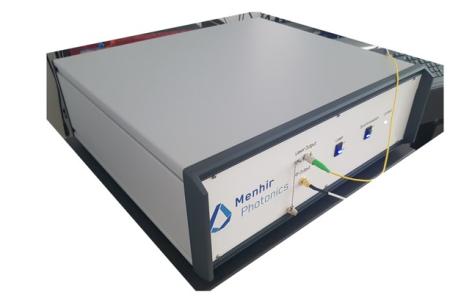De-risk assessment: MICOR : MICrowave Optical oscilatoR

The objective of the MICOR project is to prepare and develop a prototype of a mode-locked laser (MLL) based optical & microwave source. More precisely, the MICOR oscillator is capable of providing ultra-low phase noise 1-GHz optical pulse train and 10-GHz ultra-low phase noise radiofrequency signal. This source will be implemented for Earth observation applications like on-board clock generation and distribution, on-board photonics ADC, radar phase array antennas and radar local oscillator.
The market potential opened by MICOR is addressing customers and companies linked to the radar and microwave community (Hubner&Suner, Orolia, Safran etc.), which is outside the standard photonics markets. With the solution developed within MICOR, Menhir Photonics wants to address these applications, in which ultra-low noise RF signals with carriers in the 1-30 GHz range are relevant.
MICOR system was successfully assembled at Menhir Photonics and final tests performed at CSEM. The tests demonstrated the impressive noise performance of the device. The following main results have been achieved:
1. A housing was developed for reliable operation of the microwave optical oscillator.
2. Photodetector and quartz characterized for optimum repetition rate stabilization performance.
3. MENHIR-1550 laser was stabilized to a low phase noise quartz clock at 1 GHz carrier. The RF output was generated by highly linear PQW10B-L11K photodetector. “RF Output” outputs clean and quite smooth RF trace from 0 12 GHz with SNR at 90 dB (RBW=500 kHz). The RF power at 10 GHz tone was at -12 dBm.
4. Ultra low phase noise performance of the system with a resulting timing jitter at 10 GHz of <30 fs when integrating from 1 Hz – 100 kHz.
5. RIN was measured to be at <0.005 % when integrated for frequencies between 1 Hz and 100 kHz.
6. The total power consumption was measured to be at 35 W after system warm-up and 45 W right after switching on. Such power consumption is perfectly compatible with use in laboratory and ground-based systems. For space born applications there is still room for improvement and engineering work is still required to decrease it even further.
7. Long term system stability was confirmed with Allan deviation measurements lasting without interruption for 61 hours. In total MICOR system was running successfully for 1 week with various Allan deviation measurements at CSEM facilities.
